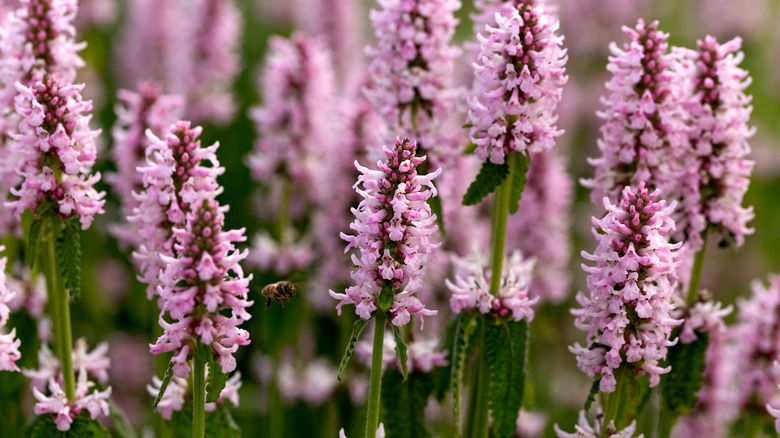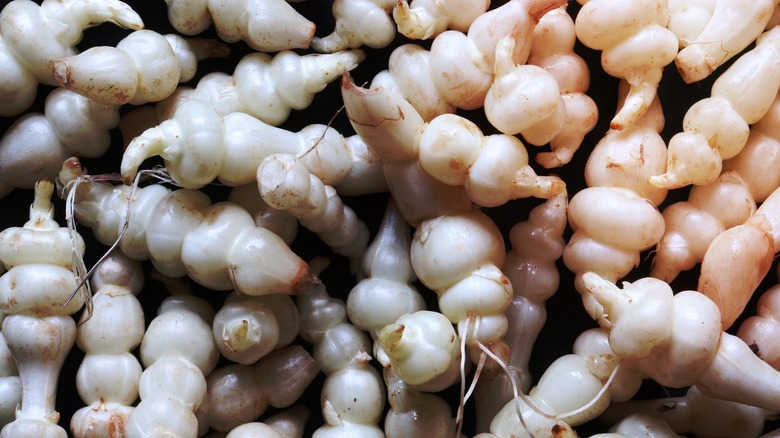What Are Crosnes And What Do They Taste Like?
We may receive a commission on purchases made from links.
Crosnes are known by many names. You may hear them being called Chinese artichokes, knotroots, chorogis, Japanese artichokes, artichoke betony, or even by their scientific name Stachys affinis. Regardless of the name used, if you've never seen these gnarly-looking tubers before, you'll likely have a lot of questions. They have a super distinct shape that almost looks insect-like, and they aren't all that common, at least not in the United States. So, what are they? Are they even edible? If so, how do you cook with them, and what do they taste like? Let's find out.
To compile a comprehensive guide on crosnes, I referenced cultivator websites, specialty produce sites, popular recipes, various chef insights, and more to bring you the most informative details available about these unique root vegetables. Keep reading to learn everything you need to know about crosnes, including what they taste like, how to use them best in your cooking creations, and the answers to any other crosnes questions you may have.
What are crosnes?
Crosnes are small root vegetables that resemble a cluster of misshapen pearls or even a small grub. It is not certain whether crosnes originally came from China or Japan, but they are most undoubtedly Asian. Around the world, they are known by many names, but these tubers got their French name, crosne, in 1887 after being introduced and cultivated in the Crosnes town in France.
Pronounced "crones," crosnes are the root of a perennial herbaceous plant that belongs to the Lamiaceae (mint) family. The tops of the plants may look similar to spearmint leaves, but the root has a unique appearance all its own. Crosnes are typically about ½ inch in diameter and about 2 inches long, but they can grow as long as 6 inches and as wide as 2 inches. The root generally consists of three to eight white to ivory-colored nodules, and their puffed-up shape often reminds people of conjoined shells or a plump caterpillar. Don't let their insect-like shape fool you, though. They are actually crunchy and quite delicious.
How and where are crosnes grown?
Crosnes' exact origins may be somewhat disputed, but they have been cultivated in Japan and China for centuries, as we mentioned. In the 1880s, they were first introduced to Europe, specifically France, and since then, they have grown in popularity and become more widespread. Today, crosnes are becoming more known by chefs in the United States and are popping up all over the place.
Thanks to their hearty nature, crosnes are reasonably simple to grow on most continents. However, they take a lot of work to harvest. Getting them to grow big tubers also requires special care and attention. They have a long growing season, from about March to October, and if you want to harvest the tubers, the plants shouldn't be allowed to flower. They can sometimes be invasive, so you should keep them away from other plants. When grown properly, the tubers start growing near the end of summer and can be harvested once the foliage dies in the fall.
What do crosnes taste like?
When it comes to flavor, crosnes are quite unique. Their taste is often compared to sunchokes or Jerusalem artichokes. Neither of those are that common, though, so if you're wondering what that means, you are not alone. Suffice it to say that crosnes have an earthy flavor profile with a distinct nuttiness and subtle sweetness. Their distinguishable taste makes them quite versatile, and they easily adapt to a variety of recipes that don't necessarily call for them, like stir-fried rice cakes with chicken or root vegetable rösti. While not typically served as the main ingredient, they add a deep flavor to many dishes. Plus, their grub-like appearance means they never go unnoticed.
Some people say the taste of crosnes is similar to artichokes, which makes sense since they are often referred to as Chinese or Japanese artichokes. However, the flavor is actually not as close as you'd think, and the texture is definitely extremely different. Unlike artichokes, crosnes have a crunchy, slightly juicy texture that is nothing like the meaty, soft consistency of artichoke hearts. Instead, crosnes are similar to the texture of water chestnuts. When you bite into one, you get lots of crunch and juiciness, something you certainly don't get with artichokes.
American crosnes vs French crosnes
There are two main varieties of crosnes: American and French. While they look the same, their flavor varies a bit. American crosnes tend to be somewhat smaller and have a more pronounced nutty flavor. Meanwhile, the French type is slightly larger and tends to be similar to a potato in terms of flavor.
According to Nature's Produce, chefs who are familiar with both types of crosnes tend to prefer the ones grown in the United States. It speculates that this is because they are grown in rich soil in the States. In France, they do things a bit differently and grow crosnes in the sand. With this in mind, the flavor will obviously differ, as plants get a lot of their nutrients from the surrounding soil, or sand in this case. Compared to soil, sand is nutrient-poor. Still, something tells us growing crosnes in the sand would make them easier to harvest, and since that's one of the main challenges of growing them, it seems like a good strategy if you are okay with a more subdued flavor.
Crosnes vs Jerusalem artichokes (aka sunchokes)
The flavors of crosnes and Jerusalem artichokes are often compared, but the plants themselves are botanically unrelated. Jerusalem artichokes, commonly called sunchokes, are members of the sunflower family. Crosnes belong to the mint family. So, the flavor may sometimes be compared, but, really, the plants are nothing alike. An easily identifiable difference between the plants is their flowers. Crosnes form purple flowers when allowed to bloom, which is not recommended if you plan on harvesting the tubers. Sunchokes form large yellow flowers. Both sunchokes and crosnes are root vegetables, but that doesn't mean they are botanically related.
Another main difference between sunchokes and crosnes is their origin. Crosnes hail from Asia, specifically China and Japan. Jerusalem artichokes are not native to Asia. Their name suggests they originated in Jerusalem, but surprisingly, they are actually native to North America. They didn't reach Europe until French explorer Samuel de Champlain sent them back to his native land. As they grew in popularity, they spread beyond France and it is speculated that they became known as Jerusalem artichokes due to English speakers mispronouncing their name.
How to eat crosnes
Like many other root vegetables, crosnes can be eaten raw. Their juicy, crunchy consistency adds a lot of texture and earthy flavor to dishes. Still, they are much more versatile than that. Crosnes can also be pickled, dried, and cooked in various ways. Boiling, steaming, stir-frying, baking, roasting, and grilling are all on the table, so if you want to add them to your dishes, experiment until you determine which cooking methods serve you best. For the most part, they should remain nice and crunchy no matter how you prepare them.
Pickling crosnes is pretty common, especially in Japan. The process of pickling them gives them a unique flavor thanks to the vinegar and salt. Plus, you get a chance to marinate them with other herbs and spices. Basic refrigerator pickling is super easy, too. It only takes a few minutes to clean and prep the crosnes. Then, you leave them in the fridge for eight hours, put them in airtight jars, and you're done. Once pickled, you can easily shave or slice crosnes and garnish an abundance of dishes with them. They won't be as crunchy as freshly cooked crosnes, but they definitely add a burst of flavor. Best of all, pickled crosnes last for several months without spoiling.
How to cook with crosnes
The first step to cooking with crosnes is to wash them, and considering their nodules and crevices, it's not the most straightforward task. Still, they clean up nicely with a good scrub under running water. Some chefs peel the skin off crosnes, but it isn't necessary. When raw, they make a fantastic snack and can be eaten whole. Raw crosnes also taste delicious sliced and added to salads and wraps.
You can also cook crosnes and add them to a variety of savory dishes. They add some much-needed crunch to a hearty beef stir-fry recipe, similar to water chestnuts. Crosnes also taste amazing simply sautéed in butter with garlic or steamed and topped with butter. Suppose that's not for you, and you're still struggling to find a way to incorporate crosnes into your meals. In that case, you can also substitute them in recipes that call for a similar ingredient, like sunchoke gnocchi or a seasonal chopped salad with sunchokes.
Where to buy crosnes
Crosnes are not popular enough to be sold at most grocery stores. They are also quite expensive, so commercial supermarkets may be remiss in offering them. You might have some luck tracking them down at specialty health food stores and farmer's markets but expect to do some searching. As a result, if you want to give these tasty roots a try, it is probably best to order them online. You should be able to find both dried and fresh options through online purveyors reasonably easily.
Growing your own crosnes is also a fantastic option if you enjoy gardening. However, they require a ton of patience. You may not get a very big yield, either, especially when you consider how much work goes into growing them.
Purchase 1 pound of fresh crosnes through Regalis Foods for $35.00.
Purchase 4 ounces of dried crosnes on Amazon for $20.74.
Purchase three crosnes tubers for planting through Seed World for $27.99.
Are crosnes easy to grow?
Crosnes are not super difficult to grow if you start with an established plant. Like any plant, they just need time and care. However, if you start from a seed, it could take a year or longer for the plant to grow to maturity, and then they still need time to produce tubers for harvest. During the growing season, the plants benefit from ample amounts of water. You'll also want to prune any flowers to ensure the plants aren't too drought-stressed to produce tubers.
Crosne tubers need about five to seven months to grow to the appropriate size for harvesting. Typically, you should be able to harvest the roots from a mature plant in October or November if you plant them in March. This may seem like a long time, but the tasty veggies you get at the end are worth the time and attention. Still, all things considered, if you want to try cultivating Chinese artichokes, we recommend starting with a mature plant so you get quicker results and don't have to worry about growing it for an additional year before you get any veggies to enjoy.
Crosnes nutritional information
Crosnes are typically considered a carbohydrate. They are also high in natural sugars, and they are pretty rich in fiber, calcium, potassium, and phosphorus, as well. They also have lots of vitamin C and iron. Crosnes contain about 80 calories total in every 100 grams of the root.
Crosnes also do have the potential to lower your inflammation, minimize your headaches, prevent some heartburn, promote healthy bowel movements, reduce the risk for some heart problems, and lower weight. Crosnes are also used in traditional Chinese medicine as a cold remedy. While all this sounds amazing, don't expect them to fix all your health issues. Still, they can't hurt, right? At the very least, they'll add some extra vitamins and nutrients to your diet, so you have nothing to lose and everything to gain by adding them into your regular diet (if you can find them, that is).
How to store crosnes
Once harvested, crosnes lose their moisture quite rapidly, so it is best to consume them within about a week. In the meantime, storing them in the fridge is recommended, unlike cucumbers. Some people think they should be stored in a plastic bag and others claim they are best in a bowl, or anything that is not considered airtight. Either way, a cool, dark place is best. The crisper drawer in your fridge is the perfect place because it is more temperature-controlled than the rest of the fridge where the temperature fluctuates due to the opening and closing of the door.
When crosnes are exposed to light, they start to lose their flavor and darken in color. If your crosnes start to develop soft spots, become mushy, or develop dark spots, it is probably time to throw them out. Dried crosnes can be stored in a sealed jar or bag the same way you would treat herbs and spices. Like other edible foods, the dried version will stay usable for a considerable amount of time.












